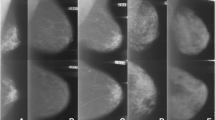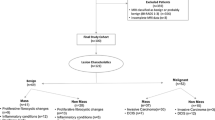Abstract
The Breast Imaging Reporting and Data System (BI-RADS) was introduced in 1993 to standardize the interpretation of mammograms. Though many studies have assessed the validity of the system, fewer have examined its reliability. Our objective is to identify predictors of reliability as measured by the kappa statistic. We identified studies conducted between 1993 and 2009 which reported kappa values for interpreting mammograms using any edition of BI-RADS. Bivariate and multivariate multilevel analyses were used to examine associations between potential predictors and kappa values. We identified ten eligible studies, which yielded 88 kappa values for the analysis. Potential predictors of kappa included: whether or not the study included negative cases, whether single- or two-view mammograms were used, whether or not mammograms were digital versus screen-film, whether or not the fourth edition of BI-RADS was utilized, the BI-RADS category being evaluated, whether or not readers were trained, whether or not there was an overlap in readers’ professional activities, the number of cases in the study and the country in which the study was conducted. Our best multivariate model identified training, use of two-view mammograms and BI-RADS categories (masses, calcifications, and final assessments) as predictors of kappa. Training, use of two-view mammograms and focusing on mass description may be useful in increasing reliability in mammogram interpretation. Calcification and final assessment descriptors are areas for potential improvement. These findings are important for implementing policies in BI-RADS use before introducing the system in different settings and improving current implementations.
Similar content being viewed by others
References
American Cancer Society. Cancer facts and figures 2009. Accessed 1 May 2009. http://www.cancer.org/downloads/STT/500809web.pdf
Wiratkapun C, Lertsithichai P, Wibulpholprasert B (2006) Positive predictive value of breast cancer in the lesions categorized as BI-RADS category 5. J Med Assoc Thai 89(8):1253–1259
Masroor I (2005) Prediction of benignity or malignancy of a lesion using BI-RADS. J Coll Phys Surg Pak 15(11):686–688
Resende LM, Matias MA, Oliveira GM, Salles MA, Melo FH, Gobbi H (2008) Evaluation of breast microcalcifications according to Breast Imaging Reporting and Data System (BI-RADS) and Le Gal’s classifications. Rev Bras Ginecol Obstet 30(2):75–79
Lazarus E, Mainiero MB, Schepps B, Koelliker SL, Livingston LS (2006) BI-RADS lexicon for US and mammography: interobserver variability and positive predictive value. Radiology 239(2):385–391 (epub 2006 Mar 28)
Coşar ZS, Cetin M, Tepe TK, Cetin R, Zarali AC (2005) Concordance of mammographic classifications of microcalcifications in breast cancer diagnosis: utility of the Breast Imaging Reporting and Data System (fourth edition). Clin Imaging 29(6):389–395
Berg WA, D’Orsi CJ, Jackson VP, Bassett LW, Beam CA, Lewis RS, Crewson PE (2002) Does training in the Breast Imaging Reporting and Data System (BI-RADS) improve biopsy recommendations or feature analysis agreement with experienced breast imagers at mammography? Radiology 224(3):871–880
Gülsün M, Demirkazik FB, Ariyürek M (2003) Evaluation of breast microcalcifications according to Breast Imaging Reporting and Data System criteria and Le Gal’s classification. Eur J Radiol 47(3):227–231
Berg WA, Campassi C, Langenberg P, Sexton MJ (2000) Breast Imaging Reporting and Data System: inter- and intraobserver variability in feature analysis and final assessment. AJR Am J Roentgenol 174(6):1769–1777
Ciatto S, Houssami N, Apruzzese A, Bassetti E, Brancato B, Carozzi F, Catarzi S, Lamberini MP, Marcelli G, Pellizzoni R, Pesce B, Risso G, Russo F, Scorsolini A (2005) Categorizing breast mammographic density: intra- and interobserver reproducibility of BI-RADS density categories. Breast 14(4):269–275
Ciatto S, Houssami N, Apruzzese A, Bassetti E, Brancato B, Carozzi F, Catarzi S, Lamberini MP, Marcelli G, Pellizzoni R, Pesce B, Risso G, Russo F, Scorsolini A (2006) Reader variability in reporting breast imaging according to BI-RADS assessment categories (the Florence experience). Breast 15(1):44–51 (epub 2005 Aug 1)
Ooms EA, Zonderland HM, Eijkemans MJ, Kriege M, Mahdavian Delavary B, Burger CW, Ansink AC (2007) Mammography: interobserver variability in breast density assessment. Breast 16(6):568–576
Baker JA, Kornguth PJ, Floyd CE Jr (1996) Breast imaging reporting and data system standardized mammography lexicon: observer variability in lesion description. AJR Am J Roentgenol 166(4):773–778
Kerlikowske K, Grady D, Barclay J, Frankel SD, Ominsky SH, Sickles EA, Ernster V (1998) Variability and accuracy in mammographic interpretation using the American College of Radiology Breast Imaging Reporting and Data System. J Natl Cancer Inst 90(23):1801–1809
Fleiss JL (1973) Statistical methods for rates and proportions. Wiley, New York, pp 598–626
Wenkel E, Heckmann M, Heinrich M, Schwab SA, Uder M, Schulz-Wendtland R, Bautz WA, Janka R (2008) Automated breast ultrasound: lesion detection and BI-RADS classification—a pilot study. Rofo 180(9):804–808 (epub 2008 Aug 14)
Caramella T, Chapellier C, Ettore F, Raoust I, Chamorey E, Balu-Maestro C (2007) Value of MRI in the surgical planning of invasive lobular breast carcinoma: a prospective and a retrospective study of 57 cases: comparison with physical examination, conventional imaging, and histology. Clin Imaging 31(3):155–161
Thomas A, Fischer T, Frey H, Ohlinger R, Grunwald S, Blohmer JU, Winzer KJ, Weber S, Kristiansen G, Ebert B, Kümmel S (2006) Real-time elastography—an advanced method of ultrasound: first results in 108 patients with breast lesions. Ultrasound Obstet Gynecol 28(3):335–340
Teifke A, Vomweg TW, Hlawatsch A, Nasresfahani A, Kern A, Victor A, Schmidt M, Bittinger F, Düber C (2006) Second reading of breast imaging at the hospital department of radiology: reasonable or waste of money? Rofo 178(3):330–336
Lorenzen J, Wedel AK, Lisboa BW, Löning T, Adam G (2005) Diagnostic mammography and sonography: concordance of the breast imaging reporting assessments and final clinical outcome. Rofo 177(11):1545–1551
Yamada T, Saito M, Ishibashi T, Tsuboi M, Matsuhashi T, Sato A, Saito H, Takahashi S, Onuki K, Ouchi N (2004) Comparison of screen-film and full-field digital mammography in Japanese population-based screening. Radiat Med 22(6):408–412
Pijnappel RM, Peeters PH, Hendriks JH, Mali WP (2004) Reproducibility of mammographic classifications for non-palpable suspect lesions with microcalcifications. Br J Radiol 77(916):312–314
Castella C, Kinkel K, Eckstein MP, Sottas PE, Verdun FR, Bochud FO (2007) Semiautomatic mammographic parenchymal patterns classification using multiple statistical features. Acad Radiol 14(12):1486–1499
Baker JA, Kornguth PJ, Lo JY, Floyd CE Jr (1996) Artificial neural network: improving the quality of breast biopsy recommendations. Radiology 198(1):131–135
Gupta S, Chyn PF, Markey MK (2006) Breast cancer CADx based on BI-RAds descriptors from two mammographic views. Med Phys 33(6):1810–1817
Skaane P, Diekmann F, Balleyguier C, Diekmann S, Piguet JC, Young K, Abdelnoor M, Niklason L (2008) Observer variability in screen-film mammography versus full-field digital mammography with soft-copy reading. Eur Radiol 18(6):1134–1143 (epub 2008 Feb 27)
Perisinakis K, Damilakis J, Kontogiannis E, Gourtsoyiannis N (2001) Film-screen magnification versus electronic magnification and enhancement of digitized contact mammograms in the assessment of subtle microcalcifications. Invest Radiol 36(12):726–733
Venta LA, Hendrick RE, Adler YT, DeLeon P, Mengoni PM, Scharl AM, Comstock CE, Hansen L, Kay N, Coveler A, Cutter G (2001) Rates and causes of disagreement in interpretation of full-field digital mammography and film-screen mammography in a diagnostic setting. AJR Am J Roentgenol 176(5):1241–1248
Thomas A, Kümmel S, Fritzsche F, Warm M, Ebert B, Hamm B, Fischer T (2006) Real-time sonoelastography performed in addition to B-mode ultrasound and mammography: improved differentiation of breast lesions? Acad Radiol 13(12):1496–1504
Martin KE, Helvie MA, Zhou C, Roubidoux MA, Bailey JE, Paramagul C, Blane CE, Klein KA, Sonnad SS, Chan HP (2006) Mammographic density measured with quantitative computer-aided method: comparison with radiologists’ estimates and BI-RADS categories. Radiology 240(3):656–665 (epub 2006 Jul 20)
Taplin SH, Ichikawa LE, Kerlikowske K et al (2002) Concordance of breast imaging reporting and data system assessments and management recommendations in screening mammography. Radiology 222(2):529–535
Pisano ED, Yaffe MJ (2005) Digital mammography. Radiology 234(2):353–362
Hambly NM, McNicholas MM, Phelan N, Hargaden GC, O’Doherty A, Flanagan FL (2009) Comparison of digital mammography and screen-film mammography in breast cancer screening: a review in the Irish breast screening program. AJR Am J Roentgenol 193(4):1010–1018
Skaane P, Hofvind S, Skjennald A (2007) Randomized trial of screen-film versus full-field digital mammography with soft-copy reading in population-based screening program: follow-up and final results of Oslo II study. Radiology 244:708–717
Pisano ED, Gatsonis C, Hendrick E et al (2005) Diagnostic performance of digital versus film mammography for breast-cancer screening. N Engl J Med 353:1773–1783 (erratum in N Engl J Med 2006; 355:1840)
Rastogi T, Hildesheim A, Sinha R (2004) Opportunities for cancer epidemiology in developing countries. Nat Rev Cancer 4:909–917
Alwan A (1997) Non-communicable diseases: a major challenge to public health in the region. East Mediterr Health J 3:6–16
Kanavos P (2006) The rising burden of cancer in the developing world. Ann Oncol 17(Suppl 8):viii15–viii23
Gelman A, Hill J (2006) Data analysis using regression and multilevel/hierarchical models. Cambridge University Press, Cambridge
Lesaffre E, Rizopoulos D, Tsonaka R (2007) The logistic transform for bounded outcome scores. Biostatistics 8(1):72–85 (epub 2006 Apr 5)
Acknowledgments
Crespi was supported by NIH CA 16042.
Author information
Authors and Affiliations
Corresponding author
Rights and permissions
About this article
Cite this article
Antonio, A.L.M., Crespi, C.M. Predictors of interobserver agreement in breast imaging using the Breast Imaging Reporting and Data System. Breast Cancer Res Treat 120, 539–546 (2010). https://doi.org/10.1007/s10549-010-0770-x
Received:
Accepted:
Published:
Issue Date:
DOI: https://doi.org/10.1007/s10549-010-0770-x




